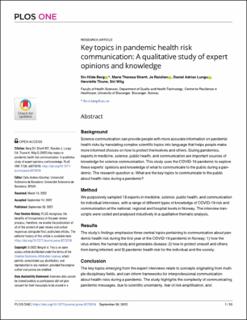| dc.contributor.author | Berg, Siv Hilde | |
| dc.contributor.author | Shortt, Marie Therese | |
| dc.contributor.author | Røislien, Jo | |
| dc.contributor.author | Lungu, Daniel Adrian | |
| dc.contributor.author | Thune, Henriette | |
| dc.contributor.author | Wiig, Siri | |
| dc.date.accessioned | 2023-01-05T13:52:29Z | |
| dc.date.available | 2023-01-05T13:52:29Z | |
| dc.date.created | 2022-10-03T11:30:41Z | |
| dc.date.issued | 2022 | |
| dc.identifier.citation | Berg, S. H., Shortt, M. T., Røislien, J., Lungu, D. A., Thune, H., & Wiig, S. (2022). Key topics in pandemic health risk communication: A qualitative study of expert opinions and knowledge. | en_US |
| dc.identifier.issn | 1932-6203 | |
| dc.identifier.uri | https://hdl.handle.net/11250/3041309 | |
| dc.description.abstract | Background
Science communication can provide people with more accurate information on pandemic health risks by translating complex scientific topics into language that helps people make more informed choices on how to protect themselves and others. During pandemics, experts in medicine, science, public health, and communication are important sources of knowledge for science communication. This study uses the COVID-19 pandemic to explore these experts’ opinions and knowledge of what to communicate to the public during a pandemic. The research question is: What are the key topics to communicate to the public about health risks during a pandemic?
Method
We purposively sampled 13 experts in medicine, science, public health, and communication for individual interviews, with a range of different types of knowledge of COVID-19 risk and communication at the national, regional and hospital levels in Norway. The interview transcripts were coded and analysed inductively in a qualitative thematic analysis.
Results
The study’s findings emphasise three central topics pertaining to communication about pandemic health risk during the first year of the COVID-19 pandemic in Norway: 1) how the virus enters the human body and generates disease; 2) how to protect oneself and others from being infected; and 3) pandemic health risk for the individual and the society.
Conclusion
The key topics emerging from the expert interviews relate to concepts originating from multiple disciplinary fields, and can inform frameworks for interprofessional communication about health risks during a pandemic. The study highlights the complexity of communicating pandemic messages, due to scientific uncertainty, fear of risk amplification, and heterogeneity in public health and scientific literacy. The study contributes with insight into the complex communication processes of pandemic health risk communication. | en_US |
| dc.language.iso | eng | en_US |
| dc.publisher | PLOS | en_US |
| dc.relation.uri | file:///C:/Users/2912882/Downloads/journal.pone.0275316.pdf | |
| dc.rights | Navngivelse 4.0 Internasjonal | * |
| dc.rights.uri | http://creativecommons.org/licenses/by/4.0/deed.no | * |
| dc.title | Key topics in pandemic health risk communication: A qualitative study of expert opinions and knowledge | en_US |
| dc.title.alternative | Key topics in pandemic health risk communication: A qualitative study of expert opinions and knowledge | en_US |
| dc.type | Peer reviewed | en_US |
| dc.type | Journal article | en_US |
| dc.description.version | publishedVersion | en_US |
| dc.rights.holder | The author | en_US |
| dc.subject.nsi | VDP::Medisinske Fag: 700 | en_US |
| dc.source.volume | 17 | en_US |
| dc.source.journal | PLOS ONE | en_US |
| dc.source.issue | 9 | en_US |
| dc.identifier.doi | 10.1371/journal.pone.0275316 | |
| dc.identifier.cristin | 2057780 | |
| dc.relation.project | SHARE - Centre for Resilience in Healthcare: 5091 | en_US |
| cristin.ispublished | true | |
| cristin.fulltext | original | |
| cristin.qualitycode | 1 | |

